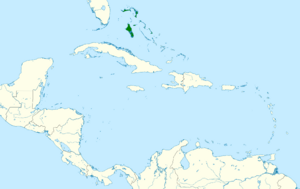Bahama yellowthroat facts for kids
The Bahama yellowthroat (Geothlypis rostrata) is a small, colorful bird. It's a type of New World warbler, which means it's a songbird found in North and South America. These birds live all year round in the Bahamas, which is a group of islands. They are endemic to the Bahamas, meaning they are found naturally nowhere else in the world!
Quick facts for kids Bahama yellowthroat |
|
|---|---|
 |
|
| Conservation status | |
| Scientific classification | |
| Genus: |
Geothlypis
|
| Species: |
rostrata
|
 |
|
Contents
Meet the Bahama Yellowthroat
The Bahama yellowthroat is related to other yellowthroat birds, like the common yellowthroat. They are all part of the same bird family.
Different Kinds of Bahama Yellowthroats
Just like people can have different looks depending on where they live, Bahama yellowthroats have a few different types, called subspecies. There are three main ones:
- Geothlypis rostrata rostrata
- Geothlypis rostrata tanneri
- Geothlypis rostrata coryi
What Does a Bahama Yellowthroat Look Like?
This bird is about 15 centimeters (about 6 inches) long, which is roughly the length of a pen. It has a fairly large beak for its size.
Male vs. Female Birds
- Males: The male Bahama yellowthroat has a bright olive-green back and mostly yellow feathers on its belly. It also has a cool black "facemask" and a grey area on the front of its head.
- Females: Females look similar but don't have the black mask. Instead, their heads are mostly grey, and their bellies might be a bit whiter.
How They Differ by Island
The different subspecies have slight differences in their appearance:
- The rostrata subspecies lives on Andros and New Providence islands.
- The tanneri subspecies, found on Grand Bahama and Great Abaco islands, has a hint of yellow on the front of its head.
- The coryi subspecies, from Eleuthera and Cat islands, has a mostly yellow front of its head.
Spotting the Difference from Other Birds
It can be tricky to tell the Bahama yellowthroat apart from the common yellowthroat, especially in winter when common yellowthroats visit the Bahamas. But here are some clues:
- Bahama yellowthroats are a bit bigger and have a stronger beak.
- They move more slowly and carefully.
- Male Bahama yellowthroats have more yellow on their undersides and a larger black mask that goes further back on their neck.
- Female Bahama yellowthroats have a grey tint on their heads that common yellowthroats don't have.
What Does It Sound Like?
The Bahama yellowthroat has a loud song that sounds like wichety wichety wichety wich. It's quite similar to the common yellowthroat's song. Their call, however, is a softer jip.
Where Do Bahama Yellowthroats Live and What Do They Eat?
These birds like to live in thick, low bushes and shrubs, whether the area is dry or a bit damp. They usually prefer drier spots than where common yellowthroats hang out in winter.
Nests and Eggs
Bahama yellowthroats build their nests low down in dense plants or inside a tree stump. Their nests are shaped like a cup, and the female usually lays two eggs.
What's on the Menu?
Like other yellowthroats, they search for food low in the plants. They mostly eat insects and other small invertebrates, which are tiny creatures without backbones.
Is the Bahama Yellowthroat Safe?
This bird species is quite common in the Bahamas. However, in winter, there are more common yellowthroats around because they migrate there. Even so, the Bahama yellowthroat is not currently considered endangered.


